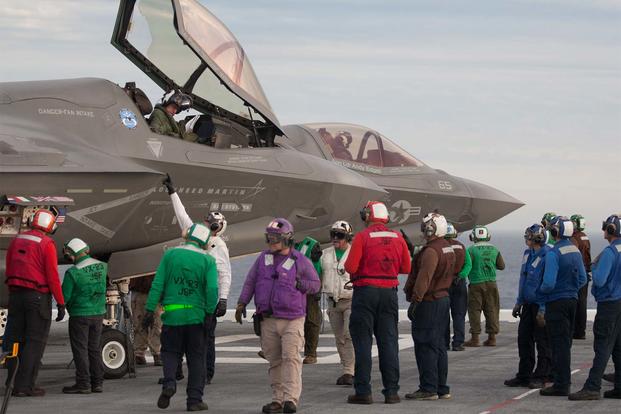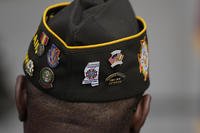ABOARD THE USS AMERICA --The surf was high where the amphibious assault ship America sailed off the coast of San Diego -- high enough to make the flight deck pitch and roll and set the conditions for a few minutes of crisis when an unfortunate sailor fell overboard and had to be rescued by helicopter.
But with sea states between three and four, indicating swells from three to eight feet, the chop was still too subdued to be ideal for this last, rigorous round of testing for the F-35B Joint Strike Fighter.
Over the next three weeks, the F-35B will be pushed to its operational limits in this, the third and last round of shipboard testing for the aircraft. It comes just two months before the first operational squadron of Marine Corps F-35s, Marine Fighter Attack Squadron 121, is set to depart for Japan to prepare for a first shipboard deployment in the Pacific that officials now say will take place in early 2018.
And unlike the two previous at-sea developmental test phases that took place aboard the 27-year-old amphibious assault ship Wasp in 2011 and 2013, this round will marry the fifth-generation aircraft with a new class of amphib specially designed to hold it, and the MV-22B Osprey, with a reinforced flight deck and no well deck, allowing additional space for aviation equipment and support.
The Marines' version of the Joint Strike Fighter is the only one equipped with a powerful lift fan for short takeoff and vertical landing -- enabling the aircraft to land on and operate from amphibs, which have a smaller flight deck than carriers and are not equipped with the arrested landing and catapult system that carriers use to compensate for the lack of runway.
The ultra-hot pillar of thrust created by those lift fans can create its own problems, though.
"When they brought [the F-35B] out on Wasp, within three passes, it had almost obliterated the standard non-skid. It just made it smooth," Lt. Cmdr. Matt Miller, the outgoing assistant air department head for the America, told Military.com. "Not only is that non-effective; there's a lot of risk of [foreign objects and debris] and everything else."
During a nine-month post-shakedown availability maintenance period, the America received a coating of the non-skid solution 28E ARCTEC in a handful of spots where the F-35B was expected to land. The Wasp now uses thermion coating, which can stand up to the heat of a landing F-35, but includes the ingredient chromium, requiring additional environmental and exposure precautions when applied.
There were other external fixes, too, that had to take place to accommodate the F-35. Fixed nets near the bow had to be reinforced. Side lifelines, typically made out of nylon cord, were redesigned in stainless steel. And the ship's commercial broadband satellite program (CBSP) antenna, a large, white dome-like device, had to be moved some 30 to 40 feet from its original location toward the stern of the ship after construction.
"Unfortunately, it was in the direct approach path of the F-35, and it was going to basically melt," Miller said.
Related Video:
Marine Corps Gets Rough With F-35B
Testing for Weaknesses
This final shipboard testing phase will give F-35 test pilots the chance to push the platform to operational extremes to ensure it will perform as expected under pressure. That means carrying a full internal weapons load-out, including later this month the GAU-22 gun pod, designed specifically for the F-35B and F-35C Marine Corps and Navy variants, that can rain down fire at the rate of 3,300 rounds per minute.
The aircraft also will practice flying with an asymmetric load-out, taking off from the ship mounted with concrete "blue bombs" standing in for real thousand-pound ordnance, and jettisoning part of the load at a designated point over the water before returning.
"We'll take off with the full external load-out on the front of the ship, and we're going to go out and drop half of it, so the aircraft is maximum asymmetrically loaded," said Marine Maj. Rob Guyette, a test pilot from the F-35 Pax River Integrated Test Force based in Patuxent River, Maryland. "So it's the hardest problem for the flight control system, and then we land it that way in crosswinds."
The pilots will take off and land at night on choppy seas and in uncertain weather conditions, highlighting the aircraft's precision landing technology.
This will also give pilots the chance to return to areas of concern and weaknesses revealed in previous tests. In the 2013 test aboard the Wasp, one aircraft experienced an "uncommanded sink" -- a frightening event in which the plane loses altitude despite the pilot's maneuvering, said Andrew Maack, chief test engineer for the F-35 integrated test force.
The event, he said, was likely caused by hot gas ingestion from the plane's interaction with the island, the structure in the center of the deck housing the ship's bridge and other command features.
The America has a differently shaped island, one of the features being tested for the ship class during the evolution.
But the goal, Maack said, is to look for ways to operate within these previously identified danger zones, rather than planning to avoid them.
"We will now intentionally be looking for it," he said. "We've got an airplane we've got a lot of confidence in, that we can safely operate to and further expand that envelope that we previously avoided. We'll say, 'Yep, it's safe to operate here. You could experience this, but you'll recover and you'll be OK.' "
Three days into testing, the pilots had completed required takeoff and landing qualifications on the ship and had begun night operations as part of the testing cycle.
Hoping for Choppy Seas
Planners hope the choppy waves will reach Sea State 5, with swells between 8 and 13 feet, to test the full operational envelope for the ship. But in pitch darkness with sprinkling rain and a rolling deck on the first night, there was plenty to challenge pilots landing on the relatively small deck of an amphib.
"When I initially qualified on an aircraft carrier on an F/A-18 [Hornet], in the daytime, it was challenging. At nighttime, it was an emotional experience," Guyette said. "... Last night was dark, real dark. One percent illumination, overcast, no moon, raining. It was my first time landing on a ship at night, and it was fun."
The difference is the built-in technology that allows pilots to note a few variables and then let the aircraft adjust for the slope of descent, the position of the ship, and other factors that require nerve-wracking precision when they must be managed by a human pilot.
"The idea is to take that major element, to get off the ship and get back on the ship, and quit making that the major item that has to be," Maack said. "So these guys can spend their time with tactics training instead of takeoff and land training."
Though the tests have gone without incident so far, there is little room for error or correction. After the Marine Corps deploys its first squadron of F-35Bs to the Pacific aboard the Wasp in early 2018, it will send another squadron out aboard the amphibious assault ship Essex only months later. That deployment may well find the ship in the Middle East, with opportunities for the F-35 to conduct real-world combat operations for the very first time.
Deployments aboard the America, which entered service in 2014, and future amphibs in its class, are still years away.
"Our first deployment is ... coming at us like a freight train," said Lt. Col. Richard Rusnok, the officer in charge of the F-35B detachment of Marine Operational Test and Evaluation Squadron 1. "We're looking at all the opportunities to increase the level of experience with all of the folks that are going to touch the airplane, operate the aircraft, and then we're going to explore some interoperability issues across the whole spectrum with the Navy and with other type, model, series of aircraft out here so that we're as prepared as possible the first time we actually see a regular rotation."
Despite the impending deadline, there were indicators on the ship that others saw the "fun" aspect of the testing that Guyette mentioned.
As reporters prepared to depart the ship in an MV-22B Osprey, an F-35B executed a vertical landing on the rolling flight deck, churning up sea spray as it hovered. The Osprey crew chief threw the pilot a "hang loose" hand signal as the tiltrotor aircraft lifted off.
-- Hope Hodge Seck can be reached at hope.seck@military.com. Follow her on Twitter at@HopeSeck.
Don't Miss a Single Military.com Story
To read the full article and get exclusive benefits, sign up today.
It’s FREE
Why am I seeing this? Visit our FAQs



























